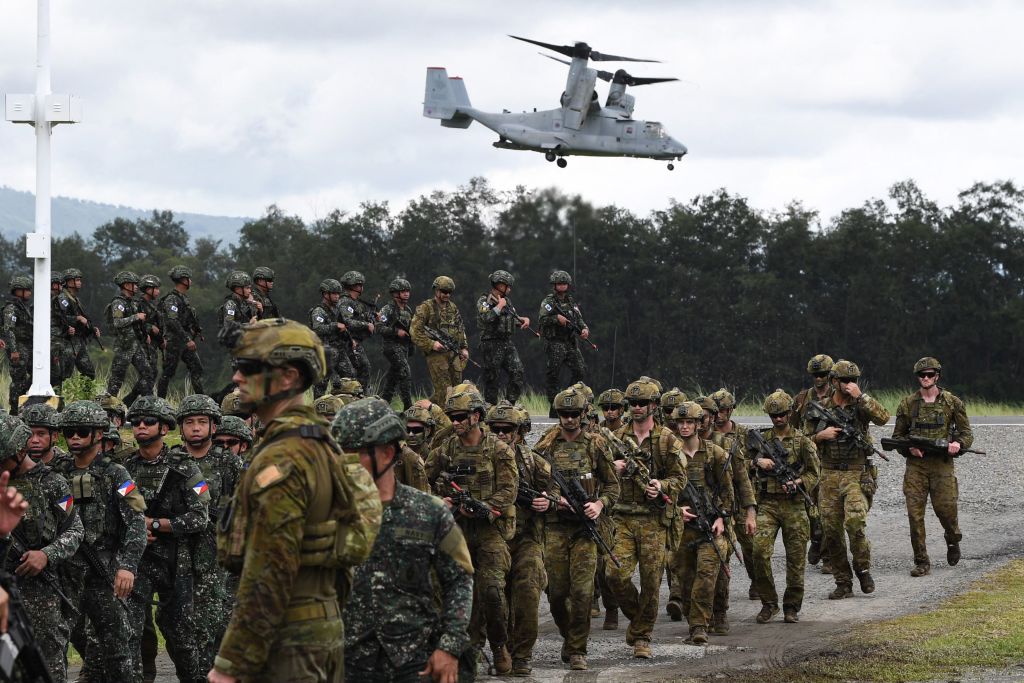
As conflicts rage in Ukraine and the Middle East, countries around the world are spending more on their militaries. In 2023, total global defense expenditure reached $2.2 trillion, a 9% increase from the previous year, a new report from the think tank International Institute for Strategic Studies revealed on Tuesday. The major drivers of this increased spending, IISS posits: the ongoing Russian war in Ukraine, and the exacerbating relationship between the U.S. and China.
Read More: U.S. General’s Prediction of War With China ‘in 2025’ Risks Turning Worst Fears Into Reality
In the Indo-Pacific, geopolitical tension between the two superpowers has increasingly pushed key countries in the region toward either Washington or Beijing, and both sides have ramped up what could be seen as preparations for potential conflict.
Across the U.S. and its allies Australia, Japan, South Korea, Taiwan, and the Philippines, total defense budgets increased by about 7.4% from about $984 billion to over $1.05 trillion between 2022 and 2023. The Philippines was the only one to reduce its military budget in 2023, though the Southeast Asian nation has expanded its cooperation with the U.S. military and strategically increased its role in the region in the past year amid growing quarrels with China over the disputed South China Sea.
The biggest increase among the U.S.’s regional partners comes from Taiwan, which boosted its defense budget by about $3 billion, or 20%, amid fears of an invasion from China.
“Generally over the last 10 years with Asia, we’ve seen defense spending increasing kind of in line with economic growth,” Fenella McGerty, senior fellow for defense economics at IISS, said during a press conference for the Military Balance 2024 report. “But the last few years we’ve definitely seen strategic factors come into play, recognition that there’s the need to spend more to maintain regional security and specifically counter Chinese influence.”
On the other side, China has found allies in North Korea and Russia, two increasingly isolated states that have rebuked a Western-led international order and also invested heavily in their militaries. China alone is outspending its neighbors: the IISS report found the country’s $219.5 billion defense spending to have accounted for 43% of all of Asia’s defense spending last year. And while North Korea’s defense spending is not publicly available, collectively, China and Russia upped their military investments by 2.6% last year, from about $416 billion spent in 2022 to $427 billion in 2023. Meanwhile, North Korea’s regular missiles tests in 2023 as well as more overt partnerships and increasingly hostile rhetoric also indicate a focus on boosting its military might.
While experts have previously said that the U.S.’s prioritization of diplomatic and defense ties in Asia does not necessarily signal the coming of a NATO-equivalent in Asia, and that Russia, China, and North Korea conducting exercises together in the Indo-Pacific isn’t necessarily a prelude to war, IISS says that China has demonstrated “increased power-projection capacity,” which has driven greater cooperation among the U.S. and its regional allies to function “as a counterbalance.”
Read More: China Is Testing How Hard It Can Push in the South China Sea Before Someone Pushes Back
Karl Dewey, IISS research associate for defense and military analysis, says that while defense spending may increase on “acute” security issues like Taiwan or the South China Sea, larger economies in the region are investing in their militaries with a more forward-looking approach: “What we’re going to see there is the longer-term positioning of their defense economies to meet longer-term threats.”
More Must-Reads From TIME
- What Student Photojournalists Saw at the Campus Protests
- How Far Trump Would Go
- Why Maternity Care Is Underpaid
- Saving Seconds Is Better Than Hours
- Welcome to the Golden Age of Ryan Gosling
- Scientists Are Finding Out Just How Toxic Your Stuff Is
- The 100 Most Influential People of 2024
- Want Weekly Recs on What to Watch, Read, and More? Sign Up for Worth Your Time
Contact us at letters@time.com